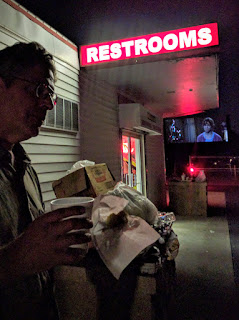To start with, both of the church pastors in these films commit multiple homicides. Certainly for most people, that fact alone would dissuade them from attending either church, but these pastors’ homicidal tendencies is but one fact of many to be learned about these churches. We'll examine the church in Sweetwater first. (The film was also released as Sweet Vengeance.)
The film opens with "Prophet" Josiah (Jason Isaacs) finding a couple of trespassers on his land in territorial New Mexico. The two starving men have killed a couple of the pastor's sheep. The clergyman knifes one man and has his underling gun down the other. Now, aside from the murder (which, as we already mentioned, is a bad thing), this incident shows the church’s lack of concern for the alien, the poor, and the hungry. That's not biblical.
January Jones, of Mad Men fame, known for her beauty and superb acting (well, one of those), plays a former prostitute trying to make a new start as a wife and farmer. Josiah kills her husband and rapes her. Again, aside from the murder, the "prophet" is not being faithful to his three wives or the prostitutes he frequents. Again, not biblical.
We hear Josiah berate Mexicans and blacks, calling them a curse on the white race; nope, not biblical.
When Jones and Marshall Ed Harris attack Josiah's church, Josiah uses his congregation members as shields to protect himself. The shepherd is supposed to be willing to lay down his life for his sheep. Once again, not biblical behavior.
Finally, the film gives an example of Josiah's preaching. He doesn't use Scripture, but rather prophecies he received from an angel (Angel Frank or Marvin or Bob or something). I do believe he was a false prophet. And the church doesn’t seem to have much of a music program.
This is not a church I'd want to go to.
It takes longer for the audience and especially the characters in 5 Card Stud to figure out that the Rev. Jonathan Rudd (Robert Mitchum) is a killer. Until that happens, he's not doing too bad a job planting a church.
When he comes into town, Rev. Rudd walks into a saloon and fires a couple of bullets from his Colt .45 into the floor. He invites everyone to come the next Sunday to the church, "God's House." (The sign in front of the church reads, "God's House - Caretaker: Rev. Rudd.") One of the men in the bar says, "You don't want me in your church. I'm the meanest, orneriest S.O.B. you ever come across."
Rudd responds, "Jesus found room for Judas at the table, so I think we can make room for you in a pew."
The next Sunday, the church is full. This firearms-in-a-bar technique of marketing probably needs further investigation. The reverend's preaching is of the hellfire variety, but since he’s condemning a very recent lynching, the harsh tone is more than justified.
Throughout the film, the preacher shows a certain proficiency with Scripture. (Though his interpretation of "'Vengeance is mine,' says the Lord" is certainly lacking) The hymn singing in the church is spirited.
Rev. Rudd also has a nice way of dealing with stereotypes of ministers. When someone asks him what a minister is doing with a gun, he responds, "When a man dons the cloth, he doesn't stop being a man."
There are a lot of things about the Rev. Rudd I very much like. I would certainly consider going to his church, if he wasn't a murderer -- which I'm afraid really is a deal breaker.
One steeple for each church.
*This review first appeared on our other blog, Dean and Mindy go to Church, back in January of 2015.






















